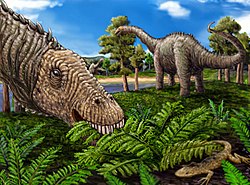| Harenadraco Temporal range: Late Cretaceous | |
|---|---|
 | |
| Life restoration | |
| Scientific classification | |
| Kingdom: | Animalia |
| Phylum: | Chordata |
| Class: | Reptilia |
| Clade: | Dinosauria |
| Clade: | Saurischia |
| Clade: | Theropoda |
| Family: | † Troodontidae |
| Genus: | † Harenadraco Lee et al., 2024 |
| Species: | †H. prima |
| Binomial name | |
| †Harenadraco prima Lee et al., 2024 | |
Harenadraco (meaning "sand dragon") is an extinct genus of troodontid theropod dinosaurs from the Late Cretaceous Baruungoyot Formation of Mongolia. The genus contains a single species, H. prima, known from a fragmentary skeleton. Harenadraco represents the first troodontid known from the Baruungoyot Formation. Since members of this family are also known from the Nemegt and Djadochta Formations, the discovery of Harendraco indicates that troodontids were important faunal components of every formation within the Nemegt Basin.



